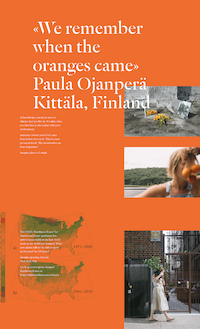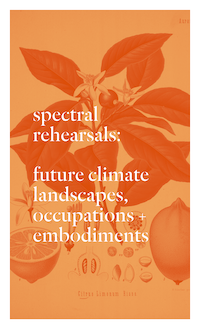Occupying Future Landscapes
OCCUPYING FUTURE LANDSCAPES
ALLIE WIST
Allie Wist’s work asks a series of essential and challenging questions, positioning the viewer inside the urgent future reshaping our environment. Her questions are embodied in 3 photographic movements Occupying Future Shorelines, Edible Geographies + Shifting Flora, and Artifacts of the Anthropocene + New Rituals, and accompanied by a toolkit for executing rehearsals of these new futures.
We have tried to quantify the magnitude of climate change for decades—we have sought to draw charts and diagrams and maps to explain our future existence. Change of plans. This is a rehearsal for those futures. We must occupy our future existence, our possible adaptations, and our new landscapes.
This body of work presents a ficto-critical and ecologically imaginatory narrative, as well as a call for exploration regarding near-future climate adaptation. It uses the language of photography and multidisciplinary art to present both an urgent and an ambivalent archetype. Which the basis of the work stems from climate change research trajectories and contemporary environmental philosophy, it is also centered around a female protagonist and her attempts to occupy future landscapes. It is at once immediate and applicable, presenting a suggestion for how individuals can perceive our current surroundings, while it also reaches towards the future, staging a rehearsal for encountering changed landscapes.
“Every landscape is haunted by past ways of life. Anthropogenic landscapes are also haunted by imagined futures.”
—Anna Lowenhaupt Tsing, et all, Arts of Living on a Damaged Planet
How can we see the embedded ghosts in our landscapes, and the phantoms of our future that haunt our environment? What vision can articulate the layered and complex interactions within our changing climate? I have made an attempt to adapt to specific near-future landscapes—to explore the creeping realities of how we might adapt to and live within these places. What maps will we need to read? What might be be eating and carrying with us? Where does urgency meld with confusion, or with apathy? Traces of our memories and our habits will linger in these spaces, as do the specters of what is to come. We may be strangers to our future selves, but we have the power to enact rehearsals of our future, and cement our ongoing relationship with the planet through imagination and narrative.
Spectral Rehearsals: Future Climate Landscapes, Occupations + Embodiments
This body of work presents a ficto-critical ecological narrative to present archetypes of both urgency and ambivalence as part of our future interaction with and action on climate change. The narrative follows a female protagonist and her attempts to occupy future landscapes. Through speculation, the project pushes viewers into potential near-future realities asking us to participate in climate action in the present. This series acts as a staged rehearsal for encountering changed landscapes and ultimately seeks to increase our proximity to climate change. While a fight goes on in the political arena regarding environmental policy, pushing for different climate futures, I am preparing for a future beyond the politics of today.
The project takes its form as staged photographs to forecast ghosts of the future. This act of staging permits an exploration of the difficult questions we face: How will our streets and shorelines change? What maps will we need to read? What might we eat and be carrying with us? What must we grow? Where does urgency meld with confusion, or with apathy? The process of rehearsal isn’t just a way to explore a new and improved relationship with the planet, it is also a way to prepare.
In the “new shorelines images,” I laminate existing areas of flooding from recent natural disasters overtop future sea level rise predictions, occupying those areas as if there were under water. I used the metric of 1-2 meters of sea level rise in my projections, which is what was predicted by 2100 at the latest in a recent study in the journal Nature. Other images feature a desalination device, highlighting the potential for water scarcity in situations of sea level rise or natural disaster. The “recipe” for desalinated water is one we may need to transfer from neighbor to neighbor or share with our families and friends.
 I take care of an orange tree in many of the images. As the United States’ “plant hardiness zones” shift northward, we may be able to grow new types of foods further north than previously. What would it look like if we could grow tropical fruit in New York City? Other foods punctuate the images as well—seaweed can help mitigate the effects of climate change through the absorption of CO2 and the sequestration of nitrogen. They can even aid in the reduction of pollution and nutrients dumped into waterways due to agricultural runoff or human waste.
I take care of an orange tree in many of the images. As the United States’ “plant hardiness zones” shift northward, we may be able to grow new types of foods further north than previously. What would it look like if we could grow tropical fruit in New York City? Other foods punctuate the images as well—seaweed can help mitigate the effects of climate change through the absorption of CO2 and the sequestration of nitrogen. They can even aid in the reduction of pollution and nutrients dumped into waterways due to agricultural runoff or human waste.
In an attempt to embed new values into physical objects, other photographs depict a series of “altars” suggestive of rituals. These speak to values of an intertwined Anthropogenic existence—part of climate action going forward will be to embed new values of eco-awareness into our daily rituals. Necessary tools to living in an altered climate may take own cultural significance and elicit the creation of heirlooms and ceremonial objects in relation to their heightened importance.
As we unintentionally act out habits in our daily lives, some with dire consequences, I ask how we might occupy near-future habits. By imagining new habits, we can also reimagine the trajectory of our footprint on our landscapes, our food system, and our shorelines. The photographs in this series embody interactions and habits which move us from contemplation to action. In the same way that photojournalism mobilizes a public to decry the events of the past and present, so to can images of the future move us into action.
While we often articulate a desire to act in regards to climate change, we are thwarted by a uniquely pervasive type of blindness which manifests in relation to change at such a massive, global scale. Our senses fall short of helping us to conceptualize the true scale of the catastrophe. Each of our actions, nonetheless, contributes to the catastrophe. As Alvin Toffler articulated in his novel Future Shock back in 1970, “Again and again the human brain has blinded itself to the novel possibilities of the future.” What novel possibilities of our future—what radical and outlandish visions of a changing world—can we bring into our daily experience now, in order to pay homage to our own limited foresight? The future of climate action will inevitably require a reconciliation with hard-to-imagine futures. I envision tangible and personal steps we can take to reduce the barriers to climate action. We will inevitably repurpose our adaptation skills as environmental challenges arise, and we will create better tools for interacting with our environment, through eating, growing, and acting in accordance with nature’s realities. Just as architects draft blueprints and build models for their engineers to take to task, I am drafting speculative outlines of a shifted future.





